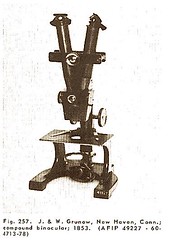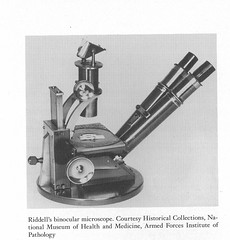
Mike Marotta submitted this article to correct an error in biographies of U.S. mint personality John Leonard Riddell. Thanks! -Editor
Preparing my presentation, “From Texas to the Moon with John Leonard Riddell” for the Money Talks forum at the ANA National Money Show
in Dallas March 1-5, I found a significant error in the accepted biographies.
Riddell served as the melter at the New Orleans Mint 1837-1849. He was a popular lecturer on science, as well as a respected botanist.
He also was apparently the first working science to publish a science fiction story.
Riddell taught chemistry at the Louisiana Medical College before it became Tulane University. It was there that he invented the
binocular microscope. Other people in America and Europe were working on the problem, as well. Riddell’s model, built in 1853 by J. & W.
Grunow of New Haven, Connecticut, is apparently the earliest known survivor of that time.
 The most detailed biography of John L. Riddell was written by Karlem Riess, and published by the Earth Sciences Department at Tulane
University, in 1977. Riess incorrectly identified Riddell’s microscope. Figure 10 in the Riess monograph is credited to the United States Army
Medical Museum. However, I found online the Billings Microscope Collection of the Medical Museum, Armed Forces Institute of Pathology, 2nd Edition,
1974, Washington, DC 20306. The microscope shown in the Riess monograph was actually built in 1867 by J. & W. Grunow of New York for Gen. George H.
Thomas. In the Billings catalog, it is number 259. The microscope built in 1853 for Riddell is number 257. The most detailed biography of John L. Riddell was written by Karlem Riess, and published by the Earth Sciences Department at Tulane
University, in 1977. Riess incorrectly identified Riddell’s microscope. Figure 10 in the Riess monograph is credited to the United States Army
Medical Museum. However, I found online the Billings Microscope Collection of the Medical Museum, Armed Forces Institute of Pathology, 2nd Edition,
1974, Washington, DC 20306. The microscope shown in the Riess monograph was actually built in 1867 by J. & W. Grunow of New York for Gen. George H.
Thomas. In the Billings catalog, it is number 259. The microscope built in 1853 for Riddell is number 257.
 The misidentification was carried forward in Long Ride in Texas: The Explorations of John Leonard Riddell by James O. Breeden,
College Station, Texas: Texas A & M University Press, 1994. Breeden edited Riddell’s journals from that three-month trek (September to November 1839)
into Comanche country seeking the lost San Saba silver mine associated with Jim Bowie. Breeden wrote a Preface and Introduction to the journal. The
Introduction chronicled the highlights of Riddell’s life. There, Breeden showed the same microscope as Riess, attributed to the National Museum of
Health and Medicine, Armed Forces Institute of Pathology. The misidentification was carried forward in Long Ride in Texas: The Explorations of John Leonard Riddell by James O. Breeden,
College Station, Texas: Texas A & M University Press, 1994. Breeden edited Riddell’s journals from that three-month trek (September to November 1839)
into Comanche country seeking the lost San Saba silver mine associated with Jim Bowie. Breeden wrote a Preface and Introduction to the journal. The
Introduction chronicled the highlights of Riddell’s life. There, Breeden showed the same microscope as Riess, attributed to the National Museum of
Health and Medicine, Armed Forces Institute of Pathology.
 When I submitted my manuscript to The Numismatist (published April 2014, and titled “The Riddle of J. L. Riddell” by the editor), I
also repeated the misidentification. Having found it in two books, I never questioned it. Only as I revisited the materials and extended my research
did the error become apparent. In point of fact, Riess also included technical drawings by Riddell for the American Association for the Advancement
of Science. Riddell presented his design at an AAAS conference in Cleveland, Ohio, the week of July 28, 1853. His plans were published in the
Proceedings. From those drawings, it is clear to me now that the finished device shown by Riess and Breeden is not the one described by the technical
illustrations. When I submitted my manuscript to The Numismatist (published April 2014, and titled “The Riddle of J. L. Riddell” by the editor), I
also repeated the misidentification. Having found it in two books, I never questioned it. Only as I revisited the materials and extended my research
did the error become apparent. In point of fact, Riess also included technical drawings by Riddell for the American Association for the Advancement
of Science. Riddell presented his design at an AAAS conference in Cleveland, Ohio, the week of July 28, 1853. His plans were published in the
Proceedings. From those drawings, it is clear to me now that the finished device shown by Riess and Breeden is not the one described by the technical
illustrations.
Wayne Homren, Editor
The Numismatic Bibliomania Society is a non-profit organization
promoting numismatic literature. See our web site at coinbooks.org.
To submit items for publication in The E-Sylum, write to the Editor
at this address: whomren@gmail.com
To subscribe go to: https://my.binhost.com/lists/listinfo/esylum
Copyright © 1998 - 2024 The Numismatic Bibliomania Society (NBS)
All Rights Reserved.
NBS Home Page
Contact the NBS webmaster
|




